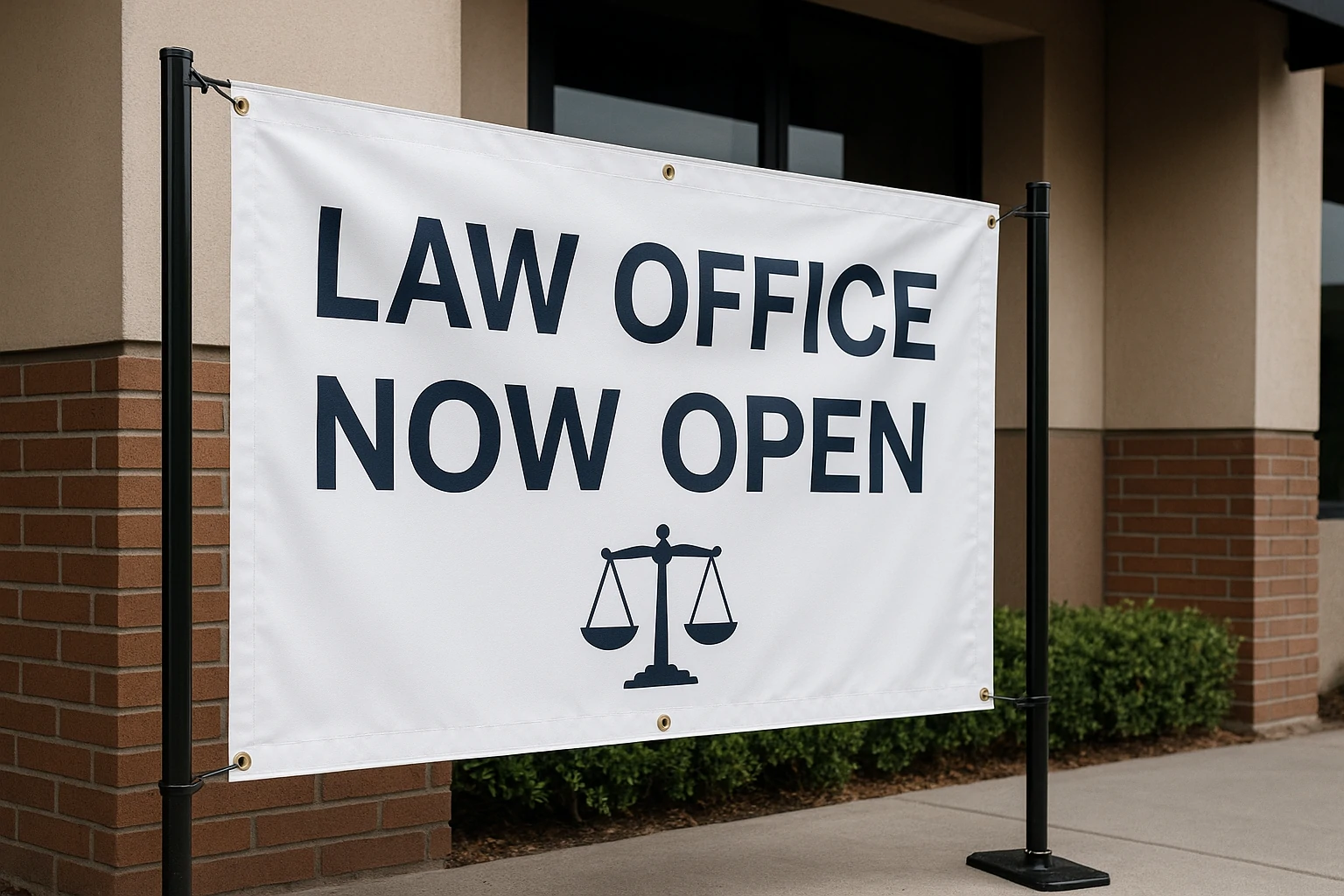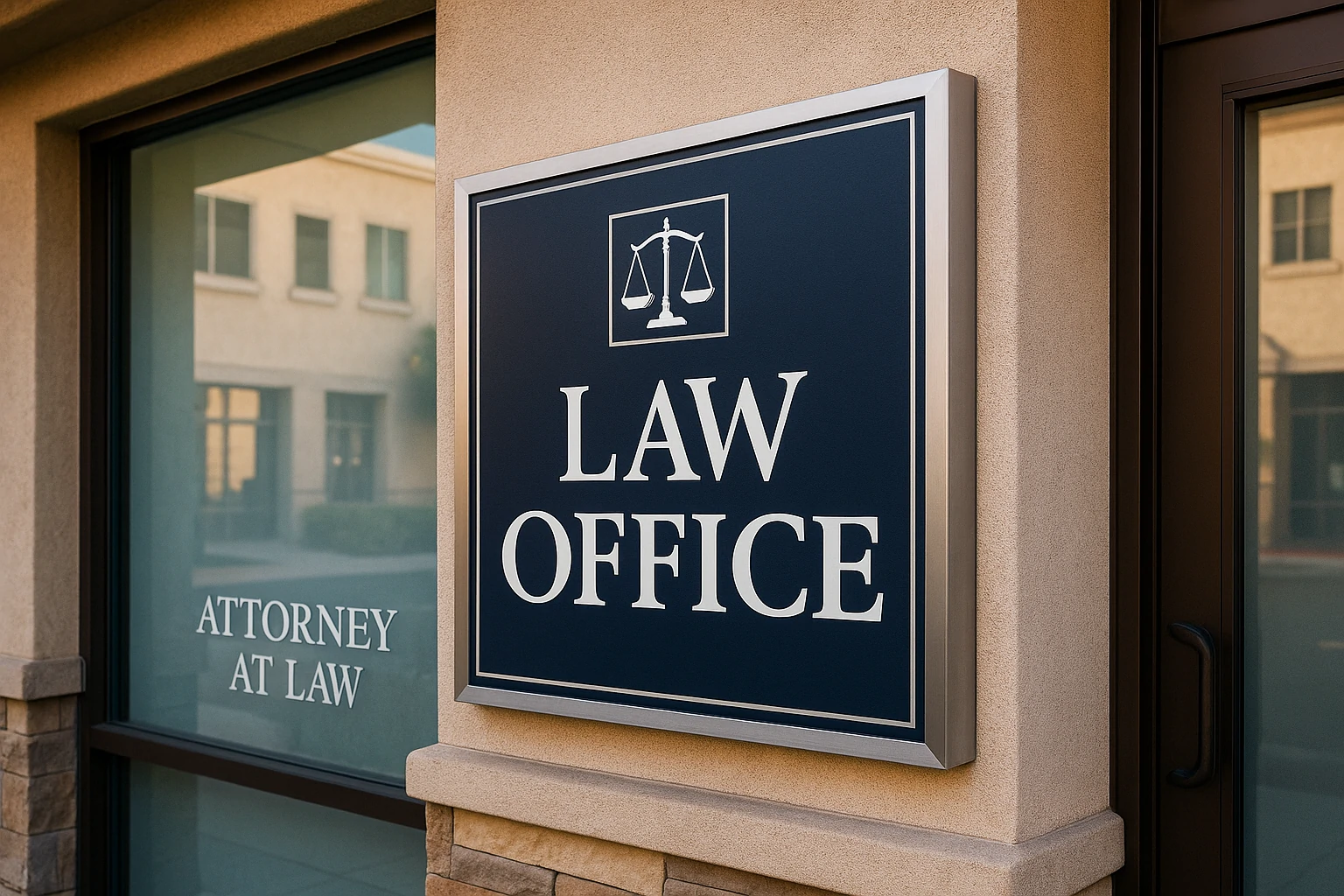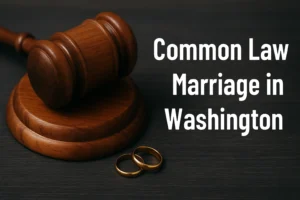Your law office sign is the first thing most clients will notice. It sets the tone before you speak a word. In Vista, California, signs are not just about style. They must meet local rules, zoning limits, and client expectations. A strong sign blends legal accuracy with visual clarity.
The legal field runs on trust. People want to know they are in safe hands. A poorly made sign sends the wrong message. A good one adds confidence. It can help your firm stand out without looking flashy or overdone.
Vista has a mix of modern and older buildings. This mix creates a unique setting for legal signs. Each structure brings different rules and design needs. From strip malls to downtown offices, signs must reflect the nature of law-calm, professional, and clear.
This guide will help you understand every part of law office signs in Vista. It covers legal limits, design tips, placement ideas, and more. It helps you choose signs that attract the right clients and avoid city code violations.
Understanding What a Law Office Sign Does
A sign speaks even when you’re not there. It points people to your door. It helps them feel sure they’re in the right place. This matters more in law than in most fields. Clients want structure. They want stability. A solid sign helps build that feeling.
In Vista, where small law firms often sit near shops, schools, or government buildings, a sign must balance location with legal duty. You cannot just post any message. You must present facts. You must avoid claims that mislead.
Signs can sit outside the office or in the windows. Some firms share space, so names go on shared boards. Others sit alone, where signs take up full wall space. No matter the type, all signs must serve one main goal, make your firm easy to find and easy to trust.
Vista Sign Codes for Law Offices
Vista law offices must follow strict city rules when it comes to outdoor signage. These codes help protect the visual tone of the city and ensure safety and fairness for all businesses.
Key Signage Rules for Law Firms in Vista
| Rule Category | Requirement |
|---|---|
| Location | Signs must be placed on the property where the law office operates. |
| Off-Site Signs | Not allowed unless a rare exemption is granted by the city. |
| Flashing/Digital | Flashing lights, animations, or moving parts are not allowed. |
| Lighting | Only soft, steady lighting is permitted. No glare or distraction. |
| Colors | Bright neon or extreme contrasts are discouraged. Signs must stay professional. |
| Permit Requirement | A city permit is required for all permanent signs, including wall, window, and monument signs. |
| Size Limit | 1 square foot of sign per 1 linear foot of building frontage (with a maximum allowed). |
| Material Approval | Materials must be listed in the permit plan and approved before installation. |
| Zoning Compliance | All signs must match the area’s zoning regulations and building type. |
Permit Application Must Include:
| Item | Details |
|---|---|
| Design Plan | Drawing with accurate size, color, text, and layout |
| Placement Map | Diagram showing where the sign will be installed on the property |
| Material List | Description of materials and finishes (metal, plastic, vinyl, etc.) |
| Contractor Info | Name and license of the installer (must be certified for commercial work) |
| Lighting Method | If the sign includes lighting, must list type and intensity |
Note: The City of Vista’s planning department reviews every submission. If the sign does not meet guidelines, you must revise and resubmit before installation.
Temporary Signage Rules for Law Offices

Some law offices in Vista need signs for short periods. This happens during remodeling, moving, or when launching a new firm. These signs must still follow city rules. You cannot place a banner anywhere or post a board on public property.
Vista allows temporary signs with a valid permit. Most of these signs last no more than 30 days. The city may extend that window, but only with written approval.
Banners, “Now Open” signs, or temporary window decals must stay neat and secure. They cannot hang loose or block views. Signs must stay on private property. They cannot lean into sidewalks, parking lots, or nearby shops.
You must remove all temporary signs once the approved period ends. If you leave a sign up without renewal, the city can issue a warning or fine. Always log the removal date. That shows you follow the law.
Short-term signs help clients find you during change. But they still carry rules. Plan ahead. Apply early. And remove on time.
Common Mistakes Lawyers Make with Office Signs
Many law offices in Vista make small mistakes that lead to big problems. These mistakes often cause delays, fines, or lost trust. Avoiding them helps your firm look sharp and stay within the law.
1. Ignoring Permit Rules
Some firms install signs without checking Vista codes. This leads to warnings or forced removal. Always apply for a permit before any sign goes up.
2. Using Hard-to-Read Fonts
Cursive, script, or decorative fonts look fancy but reduce clarity. If clients cannot read your name while driving past, the sign fails.
3. Too Much Text
Some lawyers try to list every service on one sign. That makes the design look busy. Keep it simple: firm name, logo, and legal focus.
4. Bright or Distracting Colors
Neon or glossy signs do not fit the legal field. They feel more like a sale banner than a professional brand. Clients may not take the firm seriously.
5. Missing ADA Features
Signs without contrast, Braille, or proper height can lead to compliance issues. It may also frustrate or exclude clients with disabilities.
6. Inconsistent Branding
If your office sign uses one color scheme and your website uses another, it creates confusion. Keep all materials aligned to build a strong image.
7. Skipping Regular Maintenance
Old signs with faded paint, rusted bolts, or broken lights send the wrong message. They look careless. Regular checks prevent long-term damage.
8. Placing Signs in the Wrong Spot
Signs must sit on your own property, not city sidewalks or curbs. Illegal placement causes complaints and code violations.
9. Ignoring Weather Protection
Cheap materials warp in the sun or fall apart in rain. Invest once in weatherproof materials to avoid repairs later.
10. Forgetting to Remove Old Signs
When firms move or rebrand, they often leave old signs behind. This confuses clients and makes your brand look sloppy.
Checklist: Before You Submit a Sign Permit in Vista
Vista requires a full permit for almost every permanent law office sign. Submitting an incomplete plan causes delays. Use this checklist before you apply. It saves time and helps your firm stay compliant from the start.
Basic Requirements
- Your law office operates on the property where the sign will go
- The sign will not use flashing, moving, or digital parts
- The design fits the zoning rules for your area
- The size fits within the 1 square foot per 1 foot of frontage rule
Design Plan
- Includes full color layout with text and logo placement
- Font is easy to read and not decorative
- Colors are calm, neutral, and professional
- Message is limited to firm name, logo, and legal service focus
- Layout shows clean spacing with no clutter
Placement Map
- Shows exact location of sign on building or property
- Does not block sidewalks, exits, or parking areas
- Respects property lines and height rules
- Includes measurements from all edges and surfaces
Material and Lighting Details
- Lists every material (metal, vinyl, plastic, wood, etc.)
- States whether the sign includes lighting
- Describes light type (LED, fixed bulbs) and placement
- Confirms lighting will not flash or face public roads
Installer Details
- Includes name and license number of contractor
- Confirms installer understands city code and zoning
- Shows timeline for installation and inspection
- Notes any structural needs (brackets, supports, anchors)
Final Steps
- All documents are signed
- Copies of plans are ready for city planning team
- Backup files are stored in case of loss or review delay
- Install date is planned after full approval only
Checking these boxes avoids rejections and costly changes. A strong permit plan shows your firm values structure and follows the law.
Differences Between Commercial and Legal Signage Rules
| Aspect | Commercial Signs | Legal Signs |
|---|---|---|
| Purpose | Promote sales, slogans, or brand hype | Identify law firm location and name only |
| Tone | Bold, urgent, often informal | Calm, trustworthy, and formal |
| Design | Bright colors, large graphics, animations | Neutral colors, serif fonts, clean layout |
| Materials | Plastic, vinyl, neon, or LEDs | Wood, etched glass, metal, or classic stone |
| Lighting | Flashing lights, movement, digital displays | Soft-lit, non-blinking, fixed lighting only |
| Messaging | Discounts, results, emotional language | No promises, no exaggerated claims |
| Zoning Oversight | Standard business checks | Stricter enforcement from city planners for legal compliance |
| Client Impact | Creates energy and urgency | Builds trust, credibility, and professionalism |
Why It Matters
A law office cannot build trust with the wrong type of sign. Following legal sign rules shows your firm respects the law, pays attention to detail, and stays in line with public expectations. It makes a lasting impression that builds confidence from day one.
Choosing the Right Type of Sign

Not every sign fits every office. Your choice must reflect your location, firm type, and client base. It must also respect the property owner’s rules if you rent the space.
Wall signs work well for law offices in single-use buildings. These signs go directly on the front wall, above the entry, or beside the door. They make the office easy to find from the street or lot.
Ground signs serve shared buildings. These sit near parking lots or on property edges. Each tenant gets a spot on the shared base. These signs must stay simple and often require city design approval.
Window decals help offices in busy downtown blocks. Many use etched or frosted vinyl. This allows light inside while sharing details like your firm name, attorney names, hours, and specialties.
Interior signs serve clients once inside. These help people locate your office if it’s part of a suite. These signs must follow ADA rules, including text height and placement.
Design That Reflects Legal Work
Your office sign must show what your firm stands for. It must look clear, confident, and honest. It cannot look like an ad for a store or a flashy event. Every part of the design must match the calm, serious tone of legal work.
Font Choices That Build Trust
| Font Type | Look and Feel | Why It Works |
|---|---|---|
| Serif (Times New Roman) | Classic and stable | Creates a formal, professional image |
| Bold Sans‑Serif (Arial) | Clean and modern | Easy to read at a distance |
| Avoid decorative or cursive | Fancy or thin styles | Hard to read, lowers clarity |
Tips:
- Use capital letters only when needed.
- Leave space between letters for easier reading.
- Test the font from a distance before finalizing the sign.
Color Choices That Reflect Authority
Choose colors that support your firm’s tone. Every shade sends a message.
| Color | Message Sent | Best Use |
|---|---|---|
| Black | Strength, clarity | Text or outlines |
| Navy Blue | Trust, order | Background or logo |
| Dark Green | Balance, stability | Accent or trim |
| Gray/Silver | Neutral, modern | Interior signs or trim |
Avoid:
- Neon tones
- Bright reds or pinks
- Shiny or busy backgrounds
Layout Principles That Create Calm
- Keep background space clean and distraction-free.
- Place your firm name near the top or center.
- Limit text to essentials: name, title, and logo.
- Do not use legal slogans or sales lines.
- Maintain symmetry across all edges and spacing.
A clean layout creates peace of mind. Your sign should reflect the care you give your clients.
Logos That Support Your Identity
Simple logos build memory. They should look strong at any size.
What Works Well:
- Initials inside shapes
- Thin shields or scale icons
- Balanced line designs
- Looks good in black-and-white and color
What to Avoid:
- Overused clip art
- Tiny details that fade at a distance
- Any copyrighted or unclear symbols
Make sure your logo fits your firm, not a trend.
Message Clarity
Your message must guide—not sell.
Follow these rules:
- Use your full firm name
- Add your legal focus in small text (e.g., “Estate Law”)
- Skip slogans that feel like ads
- Space your words to make the sign feel open and readable
Design Goals Recap
Your law office sign should:
- Show strength and care
- Match your legal field and office tone
- Build trust before the client steps inside
- Stay timeless, not trendy
A sign built with care leaves a strong, lasting impression.
If your legal office also handles sensitive matters like protection or restraining orders, you may want to explore how an attorney for no contact orders can help. This ensures your signage, privacy policies, and office setup match the needs of your clients.
Where to Place Signs for Best Impact
A good location improves visibility and guides clients. Street-facing signs should sit at eye level. This helps both drivers and people walking past. The sign must not block sidewalks or break building rules.
Above-door signs add clarity near the entrance. Use these when you share walls with other businesses. Add soft lighting if allowed. This helps after sunset.
If your office sits behind another building or deep inside a plaza, consider a directional sign. This sign must still meet city rules. Use arrows and suite numbers to lead visitors to the right door.
Inside, place suite plaques or directory signs near the elevator or stairs. These should match ADA height and color contrast standards. Some landlords set design standards for indoor signs too.
Avoid putting signs near loud elements like vending machines or restrooms. The area around your sign should feel quiet and organized.
Why Permits Matter in Vista
A permit protects your business. It shows the city approved your sign under local rules. Without a permit, your sign can be removed. You may also face fines or delays.
Permit costs vary based on sign type and location. You must submit a drawing, placement map, and material list. The city may request changes. You cannot install your sign until you receive written approval.
The city checks for size, color, message, and lighting. Once approved, installation must match the plan. If anything changes, you must resubmit.
Most firms use local sign vendors who understand Vista codes. These vendors often handle the paperwork. If you build signs yourself, take time to learn the full process.
ADA Rules for Office Signs
Federal law requires all public offices to meet ADA sign standards. Law offices fall under this rule. You must place signs at set heights and include tactile or Braille text where needed.
Your entry sign must have high color contrast. Do not use glossy surfaces. Fonts must be clean and simple. If your sign includes raised letters, they must meet spacing rules.
Signs near restrooms, elevators, and exits must follow the same rules. The city may inspect these after a permit is approved.
Failing to meet ADA standards can result in legal trouble. It also turns clients away, especially those with sight or mobility issues.
When to Change Your Office Sign
A good sign lasts about 5 to 10 years. Sun, rain, and time wear it down. When paint fades or letters peel, it’s time for a new one. If your firm rebrands or adds partners, you may also need a change.
Before making updates, check if your new design still meets city code. You may need a new permit. Remove the old sign before installing the new one.
Use the change as a way to show growth. Tell clients and post on your site that your sign has a new look. This keeps the brand fresh.
How Signs Help Build Your Legal Brand
In law, trust takes time. Your sign plays a quiet but key role in this. A strong sign builds name memory. Clients will feel more sure when they see it more than once.
Think of your sign as your firm’s handshake. It must feel solid. It must look clean. It must reflect your focus and values.
Good design and clear language show that you take every detail seriously. These small things help clients feel safe. That feeling leads to calls, meetings, and signed agreements.
A sign alone won’t close a case. But it opens the door in the right way.
How Law Office Signs Work in Real Life: Vista Examples
In downtown Vista, several law offices sit close to each other. Each one must stand out but still meet local laws. One firm used a navy blue metal sign with white bold letters. It sat on a stone wall near the sidewalk. The sign had no glare, no lights, and no extras. Yet, it brought steady walk-in traffic.
Another firm in a shared building used etched glass on their entrance door. It showed the firm’s name, suite number, and office hours. That simple design gave a sense of order and calm. It also matched the neutral tones of the business park.
One solo lawyer near Civic Center Drive updated her wood sign after years of sun damage. She chose a dark bronze plate with engraved gold text. The new sign gave her office new life. Clients noticed. Calls increased. The only thing that changed was the sign.
These examples show that success does not depend on size or style alone. Success comes from clarity, tone, and proper placement.
How to Pick the Right Sign Vendor in Vista
Not all vendors know city law. You need someone with local knowledge. Look for companies that work with lawyers, doctors, or accountants. They know the rules for professional signage.
Ask if they have worked in Vista before. See photos of past signs. Ask if they help with permits. A good vendor handles everything from design to install. They also explain what will pass inspection.
Avoid vendors who push too many extras. You do not need flashing lights or bright colors. You need a clean sign that follows code. If a vendor offers shortcuts or fast installs without plans, walk away.
Also, ask about materials. The sun in Vista can wear paint fast. You want high-grade metal, treated wood, or UV-safe plastics. Ask about warranty. Good vendors back their work.
A bad sign costs more than a good one. You pay once for a clean sign. You may pay twice to fix a mistake.
When a Bad Sign Breaks the Law
Vista may fine your firm if your sign breaks code. They may also order you to remove it. This hurts your business and delays client visits.
Some firms get cited for signs that block views or sit too close to the road. Others face penalties for using neon lights or moving parts. A few forget to get permits. These mistakes are common but avoidable.
One local firm put a sandwich board sign outside without approval. They faced a $500 fine. They also lost business for a week until the issue was fixed. Another posted a roof sign with too much text. The city flagged it and gave 30 days to remove it.
Legal work demands care. Your sign should follow the same standard. Stay ahead of the rules. Do not risk your name for a shortcut.
The Competitive Side of Law Office Signage in Vista
Vista is not a large city, but its legal market grows each year. Many new firms open near the Vista courthouse or off Highway 78. These firms need signs to stand out.
Some use old-school engraved plates. Others use sleek aluminum letters. A few share signs with title companies or mediators. The best signs win quiet attention. They do not yell. They do not crowd.
Your goal is not to outshine every firm on the block. Your goal is to show clients you offer skill, care, and trust. The sign must reflect that. It must make your firm feel like the right choice.
Check what signs others use. Do not copy. Learn what works. Then build something that fits you.
How Psychology Affects Law Sign Design
People react to shape, space, and color. Even before they read your sign, they form a view. A tight, clean layout feels sharp. A spaced, calm sign feels safe. A cluttered design creates doubt.
Sharp corners suggest control. Rounded shapes suggest welcome. Thin fonts feel soft. Bold fonts feel strong. Choose shapes and lines that reflect your values.
Blue suggests honesty. Green suggests care. Black and white show strength and order. Use these ideas with care. You do not need art theory. You need common sense. Pick shapes and shades that make clients feel calm and sure.
Lighting and Weather Durability
Signs in Vista face strong sun and ocean air. These damage paint, glue, and plastics. Rain can rust bolts and crack boards. Wind can shake posts or loosen parts.
Use weather-safe materials. UV-coated plastics resist sun fade. Powder-coated metals avoid rust. Sealed wood lasts longer than bare planks.
If you light your sign, use soft LEDs. Avoid blinking or color shifts. These are banned in many areas. Install shields to block glare. Do not face lights into the street.
Check lights monthly. Replace broken bulbs fast. Fix wiring before it sparks. A dead light makes your office feel empty. A bad light turns a clean sign into a hazard.
Ongoing Maintenance Tips
Clean your sign every month. Use mild soap and soft cloth. Avoid bleach or harsh sprays. Check for cracks, chips, or loose parts. Catch small problems early.
If your sign uses vinyl letters, check for peeling. If letters lift or fade, replace the whole piece. Keep extra letters on hand.
If a storm hits, check for damage. Secure bolts and check wires. If the sign falls, rope off the area and call a pro.
Plan to refresh your sign every 5 to 7 years. This keeps your firm looking sharp and active. A worn sign sends the wrong message.
Keep Your Sign and Print Materials in Sync
Business cards, websites, and letterheads must match your sign. If the sign uses one name, don’t switch it on paper. If the font is bold and square, use the same in your emails.
Clients look for signs of trust. They check if your firm keeps things in order. Consistent signs and documents show discipline. They show pride in your work.
Your logo, colors, and layout must stay stable across all tools. If you change your sign, update everything else. Never leave one part behind.
Cost Breakdown: What Vista Law Firms Spend on Signs
Vista law offices face a range of costs when creating legal signage. Prices vary based on sign type, size, materials, lighting, and professional help.
Sign Type and Estimated Cost
| Sign Type | Estimated Cost Range | Details |
|---|---|---|
| Vinyl Window Decal | $100 – $300 | Simple window lettering or etched glass effects |
| Wall-Mounted Metal Sign | $1,000 – $3,000 | Durable aluminum, steel, or bronze signs placed on building exteriors |
| Monument Sign with Lighting | $5,000+ | Ground-level structure with firm name, often lit and shared by tenants |
| Temporary Banner Sign | $150 – $500 | Short-term solution for relocation, renovation, or grand openings |
Other Common Expenses
| Service or Fee | Typical Range | Notes |
|---|---|---|
| Permit Fees | $100 – $500 | Varies by location, size, and sign type |
| Design Services | $200 – $1,000 | Custom design of logo, layout, and typography |
| Installation Labor | $300 – $1,500 | Depends on sign size, materials, and mounting surface |
| Lighting Installation | $400 – $2,000+ | Includes wiring, fixtures, and compliance with Vista lighting rules |
| Repairs and Maintenance | $100 – $600 per year | Covers cleaning, repainting, or replacing damaged parts |
Ways to Save
| Strategy | Benefit |
|---|---|
| Combine design and install | Reduces back-and-forth between vendors |
| Choose weather-safe materials | Lowers repair costs over time |
| Plan early to avoid rush fees | Keeps timeline and budget under control |
| Avoid non-compliant designs | Prevents rework or fines from the city |
If your law firm manages mass tort or pharmaceutical cases, make sure your office signs reflect professionalism and clarity. See how a Taxotere lawsuit law firm sets its visual and legal tone to support clients in complex cases.
Final Thoughts
Look at your current sign. Does it reflect your firm’s values? Can people read it from the road? Does it follow Vista laws?
If not, start planning. Make a checklist. Visit other signs in town. Write down what you like. Then talk to a sign expert. Get a plan. Submit your permit. Follow through.
Your name matters. Your words matter. Your sign is how those things appear to the world.
A clean, legal, and honest sign is not hard. It just takes care.
Let that care begin today.
Disclaimer: This content is for informational purposes only and does not serve as legal advice. Always consult a licensed attorney for legal matters. For more help, visit Lawmonarch.com.




